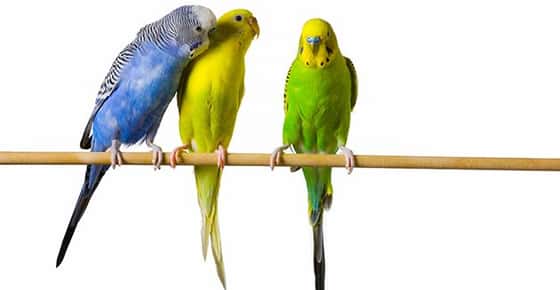
Budgies (budgerigars) are an extremely popular pet bird, and for good reason. These small parrots make delightful pets, and are usually friendly and easy to tame. While they can sometimes be difficult to understand, they are quite capable of mimicking speech. Budgies are sometimes also called parakeets (specifically shell parakeets) as they are members of the parakeet family. There are also two types of budgies - the American budgie or parakeet, and the English budgie. The American variety is the one most commonly found in pet stores, while type often seen in exhibitions and shows is the English budgie. English budgies are larger and have a different appearance than American budgies, but all budgies belong to the same species, Melopsittacus undulatus.
Their life span is 10-15 years and they can live to be up to 20. They originated in Australia and the normal wild coloration is green with black bars on the wings, back and head. Mature females have a tan or beige cere (the fleshy part around the nostrils) and the males have a bluish cere, but this is unreliable in some color variations and young birds of both sexes have pink ceres. Young budgies have bar markings on the forehead that recede with age, and their eyes have dark irises that gradually become grey with age, but again this doesn't necessarily hold true for all colors. Through selective breeding a huge variety of colors and patterns are available, such as violet, blue, yellow, pied, albino, and more. Gentle and docile bird, very easy to tame if acquired at a young age. Pairs of birds make good company for each other, but usually will not bond as well with their owners or mimic speech as well. A single bird is fine, as long as you spend a significant amount of time interacting with the budgie on a daily basis. Very playful and active, and quieter than some other parrots (although they can still be noisy).
Choosing a Bird
It is best to choose a hand fed baby or at least a young bird that has been handled regularly. You can expect to pay more for a hand reared or very young bird, but this is worth the extra cost. While widely available at pet stores, these birds may have an unknown history, and if they are older will be more challenging to bond with and tame. Look for a bird that is bright, alert and active. A bird sitting quietly with puffed feathers might be ill and is best avoided. The feathers should be smooth and shiny and lay down flat on the body. The feathers around the vent should be clean, dry, and free of fecal matter. The scales on the feet should be smooth, the nails in good condition, the beak should be smooth and well-shaped, and the nostrils should be clear and clean.
Housing Budgies
Budgies are active and playful and should have a large cage to allow room for toys and exercise. The minimum cage size is 18 inches long by 18 inches wide, and 20 inches tall, but larger is better. The spacing of the cage bars should be 1/2 inche or less. Horizontal cage bars offer the best opportunity for climbing and exercise. There should be space to place at least a couple of perches at different levels with enough space to comfortably move between them. Offering a variety of perch sizes will help keep the feet in good shape (using pesticide free, non-toxic tree branches for perches is another good option). Even with a large cage, budgies need play and socialization time outside of the cage as well. Keeping the wings trimmed is a good idea though, to prevent escapes.
Feeding Budgies
Variety is the key to a healthy diet. Seeds can be a nutritious part of the diet, but are high in fat so should only make up a part of the diet. Pelleted diets are often a good choice for birds as they are nutritionally balanced and birds can't pick out their favorite seeds and leave the rest, although budgies have a reputation for stubbornly refusing pellets if used to a seed diet. Seeds and pellets can be fed in combination, but with both seeds and pellets a wide variety of other foods should complement the diet. A variety of fresh vegetables (carrots, broccoli, corn, spinach, beans, etc.) and fruit should be offered, although persistence might be needed before your bird will try new foods (particularly if they are accustomed to an all-seed diet). Sprouted seeds are also an excellent way to add variety to your bird's diet. Avocados must be avoided. A cuttle bone can be provided as a source of calcium, but contrary to the advice given in older references and by a number of pet stores, grit is not needed and can be harmful if the bird eats too much
